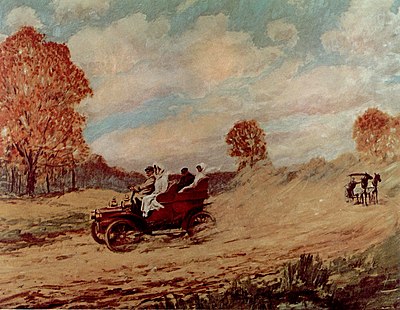
The dust nuisance.
In the summer of 1907, the OPR joined with the Massachusetts Highway Commission to make experimental application of water-gas tar and coal tar on the main New York to Boston highway and also co-operated with Warren County and Bowling Green, Kentucky, to investigate the fitness of rock asphalt as a binder for macadam.
These projects all pointed to the need for a more systematic knowledge of bituminous products and methods for using them. To get some of this knowledge, the OPE, arranged a cooperative research project with Cornell University at Ithaca, N.Y., to test the relative value, under practically uniform conditions, of different bituminous road binders applied by different methods. As its contribution to the project, the OPR added two chemists to its laboratory staff and stepped up its testing and research on asphalts and tars.
The field tests showed that both the penetration method and the mixing method of making bituminous macadam surfaces gave good results. The laboratory studies were especially fruitful:
Through its laboratory work the Office has been able to offer valuable advice in regard to specifications for bituminous road binders and in many instances to frame such specifications upon the request of various public bodies.
Many worthless road preparations have been and are at present being manufactured and sold to the public through ignorance on the part of both producer and consumer with regard to the requisite characteristics of such materials to meet local conditions. These materials are sold under trade names, and as a rule carry no valid guarantee of quality. Specifications for such materials are therefore needed for the protection of the public. . . . Some manufacturers have already followed the work of the Office along this line, and are either manufacturing materials in accordance with specifications of the Office or stand ready to do so upon request.[1]
In succeeding years the dust abatement program was enlarged, until by 1916, the OPR was involved in experiments on 28 roads in 11 States and the District of Columbia. Gradually, the emphasis shifted from “dust prevention” to “road preservation,” and the building up of tar or asphalt wearing courses over macadam, slag or gravel bases. This led to the general adoption of bituminous surfaces wherever automobiles were an appreciable portion of the total traffic.
68
- ↑ Bureau of Public Roads Annual Report, 1910, pp. 785, 786.
